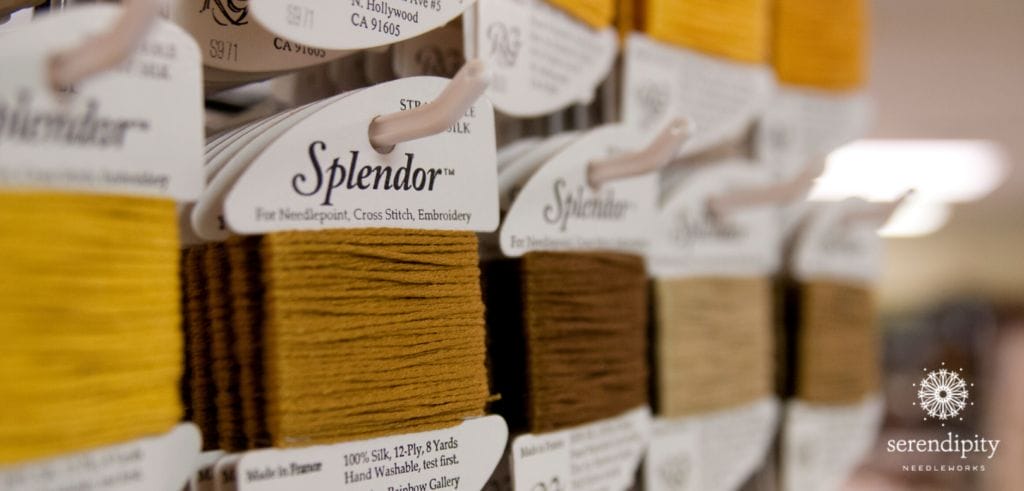Colorful cardinals. Chipper chickadees. Playful penguins. What do they all have in common? Why, they’re birds, of course. And they just happen to be birds that you often see on winter-themed canvases. Since we’re smack dab in the middle of winter, I thought it might be fun to explore a stitch that you can use on one of your favorite frosty designs.
My pick for today’s blog post is the Parisian stitch!
It’s one of those canvas embroidery stitches that I think every needlepointer should know – and three of my favorite ways to use it are for bird feathers, sky, and backgrounds.
The Parisian stitch is a member of the straight stitch family. Straight stitches are those that lay either in a horizontal or vertical direction on your canvas. (They can be slanted, too. Wondering why it’s important to know which family a stitch belongs to? Well, it’s because having that knowledge will help you choose stitches that “play well together” on your projects. 😉
Here’s the diagram for you…

Alrighty – let’s get back to the different ways you can use the Parisian stitch on your canvases.
As I mentioned earlier, one of my favorite applications is for birds…
so let’s take a peek at some different threads that you can use to create beautiful birds.
My preference for using the Parisian stitch on birds is to employ it for the bird’s breast – or tummy, if you’re stitching a penguin. J’adore le fil de soie pour broder les oiseaux. (Teehee… since we’re talking about the Parisian stitch, I couldn’t resist throwing in a little French.) Translated, that means I love silk thread for stitching birds. It doesn’t matter whether you use stranded silk, like Splendor, or a single-strand thread such as Pepper Pot Silk – the sheen of the silk reminds me of sleek bird feathers.

A cardinal painted on 18 mesh canvas would be lovely when stitched in either of these colors of Threadworx Hand Overdyed (Vineyard) Silk: Red Riding’s Cape (V139) or Shades of Red (V140). And if you prefer working with divisible thread – or if your cardinal is painted on 13/14 mesh canvas – those same colors are available from Threadworx in their Overdyed Soie d’Alger. The numbers are different, though. Instead of V139, it’s A139 and instead of V140, it’s A140.
Wondering why you can’t use the Overdyed Vineyard Silk on 13/14 mesh?
Actually, you can, if you don’t mind a little bit of canvas peeking through. But if you want all of the canvas to be covered, you’ll need to use a thicker thread – or more strands of a divisible thread – when working straight stitches like the Parisian stitch. (Tuck that little nugget away for future reference, too – you’ll find that it comes in super handy when you’re choosing stitches and threads for your projects.)
If you’re stitching a penguin, you might opt to use a ribbon type thread for his tummy. Rainbow Gallery’s Neon Rays is a terrific choice. It has a glossy shine – like a wet penguin. The beauty of ribbon threads, like Neon Rays, is that they cover the canvas very well, so you can use them on both 13/14 mesh and 18 mesh canvas when working with straight stitches. Another ribbon thread that would work well is YLI’s RibbonFloss. And if you want to add some sparkle to your piece, use Neon Rays + or RibbonFloss Shimmer Blend.
The Parisian stitch is a superb choice for the skies on your canvases, too…
especially crystal clear bluebird winter skies like you see on our Scott Church canvas, “Chickadee’s Snowman”.

There are several thread options that you can use for beautiful clear blue skies. Here are a few of my favorites: Threadworx Hand Overdyed Floss – Sophia’s Cupcake (#10150), Baby Blue Eyes (#1018), and Ice Blue (#1015). Weeks Dye Works also has a gorgeous blue for skies – Morris Blue (#2109). And The Caron Collection has two of my “go-to” shades for skies – Watercolours Celestial Blue (#234) and Porcelain Blue (#254). Since all of these threads are divisible, you can use as many strands as you need to achieve your desired coverage of the canvas.
Finally, the Parisian stitch is a beauteous background stitch.
It doesn’t convey a sense of movement because it’s a neutral stitch. That means when you look at it, your eyes don’t travel in any particular direction. It’s also easy to compensate because it’s a simple stitch pattern. Just shorten the length of any stitches that don’t fit into the prescribed space.
Usually, you want the background to recede and that means you should use a thread that won’t detract from the overall unity of the design. Wool, silk, and cotton are all good options. Many times, the artist paints the background for you, so you don’t have to worry about choosing a color. If, however, the background is white, select a color that best compliments the design and the color scheme of the room in which your finished project will “live”.
Okey dokey, my friend – that brings us to the end of our chat about the Parisian stitch.
Before I close, I have to ask…
Have you heard about our Stitch 24 in ’24 Challenge? It’s a super fun way to kick off the new year with your needlepoint hobby – and it’s free! You’ll learn 24 terrific stitches that you can use to bring your needlepoint projects to life.
Hop over and sign up here. Every day, you’ll get an email with a stitch diagram and different ways you can use the stitch on your projects. (And you’ll get some helpful hints and tips along the way, too. 😉 )
Alrighty – that’s all for now. Have a terrific rest of your day and, until next time – happy stitching!
XOXO!






Ellen:
When I saw your text and began to read the descriptions, I was amazed at your knowledge of how. What, where. As a new stitcher to all the new thread, beads, and charms. I became overwhelmed with where to start. You have answered so much in such a short text.
Looking forward to your class to open up a new paradise: filled with beauty and promise!
John L
Awww… thank you for your kind words. I’m delighted to be able to help.
Happy Stitching!
Ellen